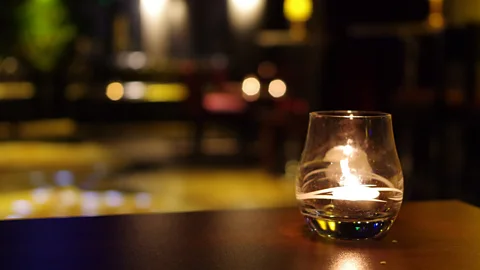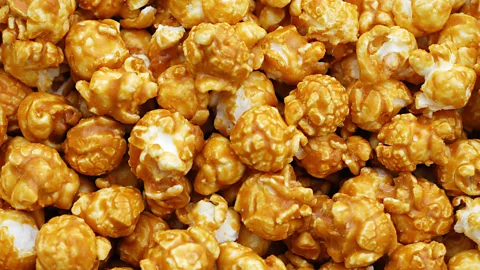What dining in the dark does to your tastebuds
 Getty Images
Getty ImagesSome restaurants around the world offer dining with a difference – guests eat in complete darkness. How does this change the way we taste?
Inside the sleek, understated restaurant lobby, a man explains the rules. No devices that make light, like watches or phones, allowed inside. Put everything in the lockers by the front door. Hang up your coats; if you take anything in, you will lose it.
In the Blind Cow, a restaurant in a stucco villa in Zurich, your expectations are a liability. In your normal life, you might be able to look around you and scoop up a handbag that's fallen to the floor. In here, behind the soot-black curtains that cloak the dining room, another reality holds sway.
Into the lobby sweeps the red-haired waiter. He indicates to line up behind him, conga-line style. Then it's off through a dim antechamber, the velvety drapes… and then, nothing.
There's the sound of a room full of people talking and laughing, the chinking of cutlery. But to the eye, there are only the dark peacock feathers that swirl across your vision when your eyelids are shut. In fact, it doesn't matter if your eyes are open. Close them, if you like. It makes no difference at all.
Dark restaurants like the Blind Cow offer a tantalising novelty – a meal eaten in complete darkness, in this case served by waitstaff who are blind or have limited vision. For them, darkness poses no obstacle. In the black of the dining rooms, they move easily and surely, while the sighted remain rooted to their chairs, unable to navigate.
You might also like:
Though there are now a smattering of such places around the globe, the Blind Cow was the first permanent instantiation, founded in 1999 by a blind clergyman. I am here today with my sister, and as I fumble for the back of my chair, my senses reeling, I wonder how eating in darkness feels different for someone with sight. In the absence of vision, do the other senses grow sharper? Do you eat less when you have no idea what you're eating? And what does being in the dark do to other aspects of your mind?
 Getty Images
Getty ImagesThe first bite makes it clear just how strange an experience this will be, at least for me. The waiter's voice tells us that before us is a spoon with an amuse-bouche. I grope until I find the cold metal thing, then bring it to my lips. I am conscious of many small knobs and plumes, as if I am eating a mossy log sprouted with mushrooms. I cannot put a name to it. In my mind's eye, the thing's black shape is outlined with white, a stand-in for visual information. My sister says there might be some apple; there is perhaps some cabbage. But without an image to peg my impressions on, the moment after I swallow, I can recall almost nothing about the mouthful.
A long line of psychologists have studied the effects of sight on memory. People asked to recall what they've heard – from recordings of busy pool halls to dogs barking – have a harder time than if asked to recall what they've seen. Memories tested on the same day they are formed are much clearer if the information is visual, another study found; auditory information is recalled more coarsely, without as much specificity. Awash in a sea of blackness and texture, I am aware of how very much my eyes keep records.
Determined to do better this time, my sister and I commit to experiencing the next course together, and unpicking its identity with nothing but our tongues. There are definitely slivers of crisp raw cabbage, tart dried fruit, and even, she insists, a grape. Walnuts? There is a sudden, chilly pile of dressing, like yogurt or cottage cheese. We struggle to connect the rush of sensory information, accompanied by fleeting glimpses of the past – I last ate this, whatever it is, in a field somewhere, with some friends – to a name.
But we are better at ing this course, focused as we are on skewering each of these perceptions like butterflies on pins and asg them designations.
What is far less tricky is the physical task of eating in the dark. As long as I run my fork around the edge of the plate in a circle each time, checking with my lips to see if I've pulled anything up, I can clean my plate with ease. The main course arrives – beef, not lamb, we decide, on a bed of pureed something. We cycle through obscure vegetables before it finally clicks: parsnip! Cubes of squash and pumpkin seeds swim in the sauce, providing an unexpected crunch. Sweeping my fork about the plate's rim, I am strangely thorough with this food I cannot see. I eat it all up.
 Getty Images
Getty ImagesThat tallies with a rare study on dining in the dark, which found that without vision to guide them, people can consume much more food than normal without realising it. Some dark diners in the study were given normal portions and some super-sized portions, and after the meal, all diners had a self-serve dessert in a well-lit room. Though the super-sizers ate 36% more calories than the others, they ate just as much dessert and were about as hungry afterwards as the others.
That suggests that actually seeing the food before us might feed into our calculations of how hungry we should be. For my part, I eat everything I can scoop up with my fork, the excitement of the chase blunting whatever I might be getting from my stomach.
(That's not to say there are no physical difficulties in this meal. I order a dry red wine and immediately try to pour it up my nose. In the darkness, I can't tell how tall the bulb of the wine glass is, and hence where to aim it.)
The restaurant grows quieter. Several of the groups of voices we've grown to recognise are gone. There are stories of people panicking in the silken obscurity of dark restaurants, perhaps unnerved by true dark. In a way, the restaurants have something in common with the sensory deprivation chambers used by the psychologists who first studied the seeking of sensation, a fundamental part of our personalities. Some people do not respond well to being without stimulation, while others find it soothing, and still others may begin to sing to the time.
Our dessert course arrives, heralded by the waiter's voice over my shoulder. I dip my spoon in and have not the faintest idea what this is, except that it is very, very familiar. Cardamom… little crunchy sweet bits... a soft, grainy paste. I eat what seems a massive quantity of this, mulling what could make me think of summer evenings at my parents' house, of street fairs, redolent with the caramel smell of waffles.
 Getty Images
Getty ImagesI find that my senses of taste, smell, and touch are not sharper than usual. The main difference is they are disted, in the absence of the unifying power of vision. It takes encountering a horrifyingly crunchy thing on my spoon, like chewing on a beetle, to jolt me into recognition: it's chestnut cream, or crème des marrons, sprinkled with a crunch.
My final bite of the meal is unmistakable: a single piece of caramel popcorn, sweet and burnt.
We sip our tea and completely forget to eat the cookies on the saucers because we can't see them. It is truly a relief, we realise, not to be seen. Invisibility lifts from you the responsibility to look a certain way or eat a certain way or keep things tidy. You can slouch. You can just sit and talk and think and you are only a voice in the darkness like any other, finally free of your body.
We call out quietly to the waiter: we are ready to go.
When we emerge into the lobby, we ask about the time. Stranded without phones or watches, it feels to us like we've been in darkness for about 45 minutes. We are shocked to find that two hours have ed. With no vision to anchor it, our ability to keep track of time has gone wandering. Perhaps it is no surprise that for creatures like ourselves, with no practice in darkness and a lifetime of light, time without sight is featureless.
Some months after that unusual meal, I find myself struggling to reconstruct the taste and sensations I experienced in the dark. Almost all that remains is that strange snapshot of the first bite, its shape a glowing emptiness in my mind's eye.
--
